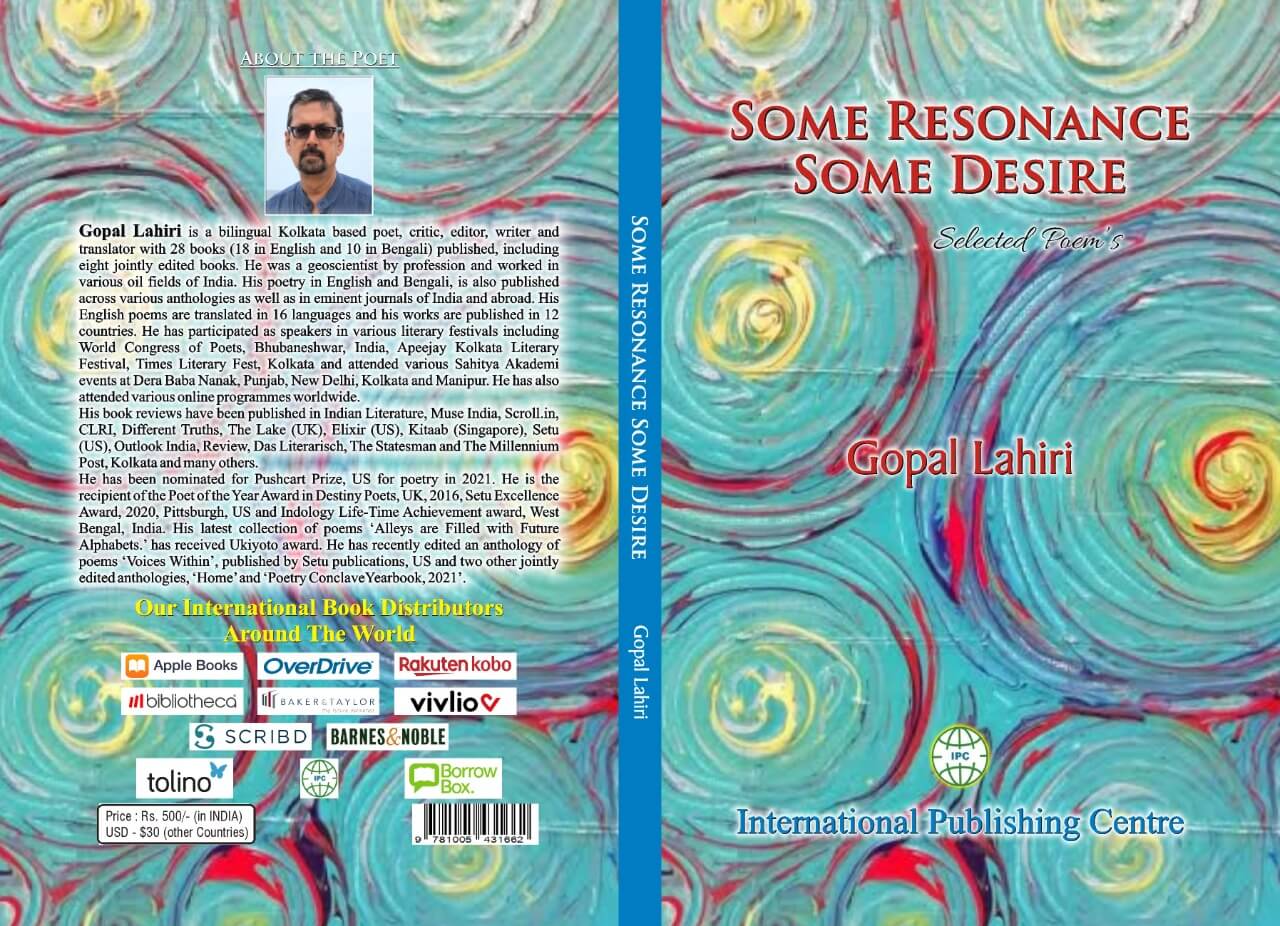Reading Time: 5 minutes
Urna reviews Gopal Lahiri’s poetry collection, “Some Resonance Some Desire,” which blurs the lines between science and poetry, exploring universal truths through metaphors and introspection. An exclusive for Different Truths.

For the worshippers of straight-jacketed thinking and the victims of a grand, sweeping pop psyche, science and poetry are hardened, self-contained polarities, sparring from two ends of a blood-smeared, carcass-laden battlefield. Arch enemies locked away in opposing world views and approaches without the faintest hope of seeing eye to eye, let alone reconciling to a peace treaty. And many of us presuppose “Never the twain shall meet,” if I were to borrow from Rudyard Kipling’s The Ballad of East and West.
Johann Wolfgang von Goethe, however, famously said that science arose from poetry…when the time comes, both can meet again on a higher level as friends. Gopal Lahiri’s Some Resonance Some Desire – Selected Poems strengthens Goethe’s premise further when we consider how Lahiri, who majored in Geology at the iconic Presidency College and is a geoscientist by profession, depends heavily and unflinchingly on the metaphor. The humble metaphor, as scientists, historians, and linguists have come to understand it, has always been at the heart of discovery—scientific, empirical, or motional, poetic, psychological, or socio-economic.
Deeper than the metaphor is the way in which Lahiri approaches individual feelings, carving out a space for “self-examination, for second judgements, for admission” with a thorough scientist’s acumen and an eye for granular details.
Some Resonance Some Desire has three distinct segments: ‘Effulgence’, ‘Cadence’, and ‘Tapestry’, and in each section, Lahiri goes about peeling the layers off the mundane and the unseeable with a poet’s hunger to paint one gentle brush stroke at a time, building thereby a canvas of sense and sensibility, landscapes and seasons, motivations, and compulsions.
The raison d’être of Lahiri’s poetry, then, is to seek and stumble upon the inexplicable…
The raison d’être of Lahiri’s poetry, then, is to seek and stumble upon the inexplicable, yet one can’t help but see how he digs and unearths a universal insight, understanding, or nuance through the particular, the minuscule, the incisive molecular structure of love and loss, memory and memorabilia, happenstance, and circumstance. Arriving at the macro through the lens of the micro and with a laser-sharp focus on imagery, scenes, echoes, shadows, and sensations.
In her elegant foreword, Santosh Bakaya, poet, novelist, essayist, and internationally acclaimed for Ballad of Bapu, writes about how Lahiri “Excels in wrapping profound truths in a surreal, dreamlike aura, turning mundane moments into magical ones, leaving one with a glow, resulting both from aesthetic and intellectual stimulation, and a fugitive undercurrent seeming to whisper eternally of an all-expansive beauty.”
In a gorgeously written preface, which also doubles up as an excavation into the mind and the workings of the poet, Lahiri talks about instigating “A different kind of possibility in poetry and a more sustained attention to language.” Having extensively read and reviewed Lahiri’s poetry, I couldn’t agree more about the funnelling down and the amplification of language employed in this collection.
Whether it’s free verse, sonnet, haiku, senryu, haibun, or memoir, Lahiri’s gaze gets hot and intense, as if peering down the petri dish of poetry, prodding, and pushing the contours of ‘Effulgence’, ‘Cadence’, and ‘Tapestry’. The concentric circles on the cover serve as both an invitation and a symbol of the “distilled poetic mien” awaiting the readers inside three cohesively structured sections.
The first section, titled ‘Effulgence’, starts with a compelling need to defy outer appearances, which may be just that—the outer shell—and Lahiri’s pen traverses through the sedimentation of stillness, beyond the glass window, to “pluck the promises” from the branches of the trees. Transporting the reader to the realm of “unspoken hopes and dreams.”
listen to the wind, wood cracking, and leaves rustling take inside the sounds of the natural world the pure joy extends beyond the visual realm. silently slipping through the glass window the aroma of the first day of this summer wafting in so many unspoken hopes and dreams. (Beyond the Visual Realm)
Often, Lahiri employs an inner compass to increasingly scrutinise the underlying experiences…
Often, Lahiri employs an inner compass to increasingly scrutinise the underlying experiences of engaging with a poetic form while alluding to poetry and connecting the powerful stimuli that are associated with a particular poetic form. Take the case of Resolve, where “Haiku climbs through the clouds of philosophy.” Throughout ‘Effulgence’, Lahiri shows how the contextual inner lining of a poem can become a mutual creation between the poet and the reader.
Haiku climbs through the clouds of philosophy picks up the pieces of your thought. Memories are kept in the long boxes and the fine tissues drop stories there. Darkness lies upon one another. Each instant is resolve and endurance. (Resolve)
Lahiri’s poetic radar comprises far more than marginalia or even philosophical explanations.
Lahiri’s poetic radar comprises far more than marginalia or even philosophical explanations. Through it, he investigates the ebb and flow of artmaking and the signposts of solitude, and his work constantly considers the role of poetry in attempting to articulate the dance of pause and ponder, of wait and awaiting. His conscious and aware unravelling and demystification of time pulls a red carpet out for the reader, not just to walk upon but to imagine unforeseeable fragments of time and what it may come to signify for each one of us. This, I think, is the cornerstone of ‘Cadence’, the second section.
I have made love to the distant skies in a different time At the water’s edge, marking lonely ripples in your name. It’s possible to dance against the boundless limit of rays To resist the storms of your face that pause and wait for years and years to peak. (Dancing Light)
In ‘Che cos’è la poesia’, Derrida proposes a traditional or classical account of the poetic. Situated somewhere between visual arts and music, by way of the kind of aesthetic classification that may be traced from Kant through Hegel, poetry is characterized in terms of its powers of condensation. Lahiri takes the powers of condensation of thought and imagery and sets them both free with the flutter of the wings of his poetic attention. We see this even more pronounced in his haiku in the last section and in Lahiri’s ‘Memoir: Return to My City’ in the section titled ‘Tapestry’.
on your writing desk the diary pages flapping lies, lies and more lies in your palm all your promises lay like toys.
The science of Lahiri’s poetry is as immutable as electromagnetics, plate tectonics, rock composition, or the laws of motion. He systematically goes about exploring the protons and electrons of why ‘Love is a Verse’ and how “My sugarless mouth insulates me from your sweet tongue”.
As his words navigate and circumnavigate the whimsical ways of the human heart and scrape off the lithosphere of “writhing pain,” Lahiri reaches out and touches the soft core of his readers. Sometimes speeding up ‘time’, and at other times slowing it down, with the sheer mastery of a pen-wielder who knows that energy is transferred from one place to another—from the poet to the reader and vice versa.
Cover photo sourced by the reviewer.


















Sheer brilliance in the manner with which Urna unfolds the event horizon between poetry and science.
What feeds the other, the resultant accretion disk is subtle poetry in her review.